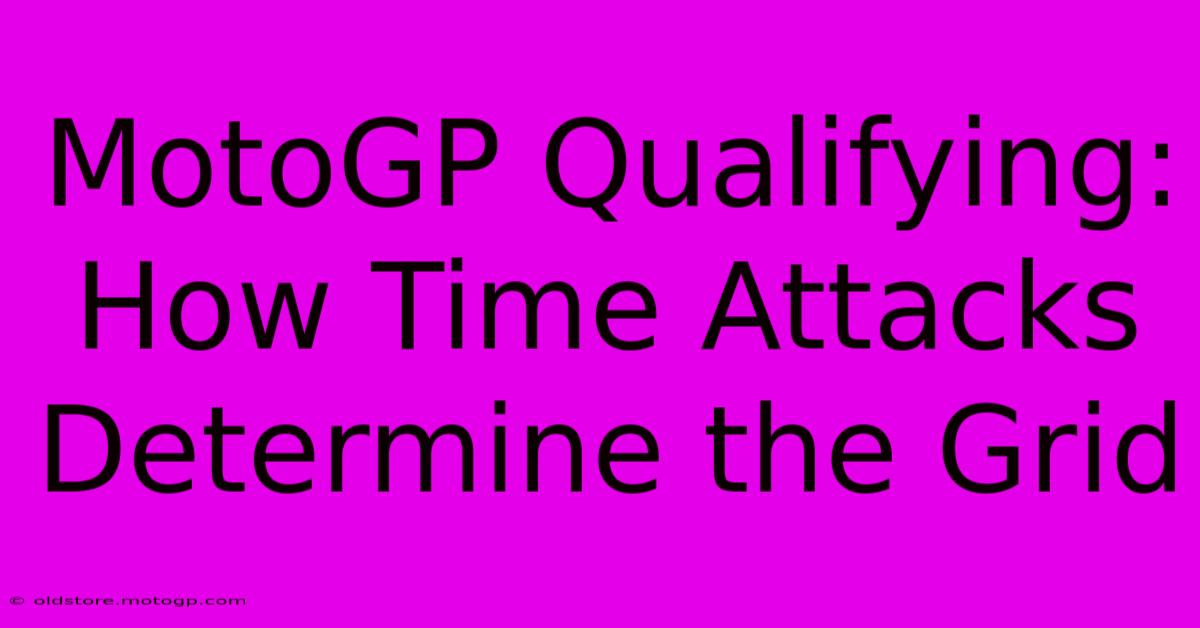MotoGP Qualifying: How Time Attacks Determine The Grid

Table of Contents
MotoGP Qualifying: How Time Attacks Determine the Grid
MotoGP, the pinnacle of motorcycle racing, features some of the most exhilarating and fiercely competitive battles on two wheels. But before the lights go out and the race begins, there's a crucial stage that sets the scene: qualifying. Understanding how MotoGP qualifying works, specifically the time attack nature of it, is key to appreciating the drama and strategy involved. This article delves into the intricacies of MotoGP qualifying and explains how these intense time attacks determine the starting grid.
The Importance of Grid Position
In MotoGP, starting position is paramount. A good starting grid position significantly impacts the race outcome. A rider starting from the front row (positions 1-3) has a substantial advantage, allowing them to avoid the initial chaos and dictate the race's pace. Conversely, starting further back means navigating through a pack of riders, losing valuable time and potentially compromising the race strategy. That's why qualifying is so critical – it’s a fight for the best possible starting spot.
Qualifying Sessions: A Breakdown
MotoGP qualifying is a multi-stage process designed to ensure fair competition and separate the fastest riders from the rest. Typically, the process unfolds across three sessions:
-
Free Practice (FP1 & FP2): These sessions allow teams to test different setups, gather data, and assess the track conditions. While not directly determining grid positions, they are crucial for setting the base for qualifying. Data gathered in free practice inform tire choice, setup adjustments and race strategy.
-
Qualifying 1 (Q1): This session features the riders who haven't achieved a fast enough lap time during Free Practice. Only the top two riders from Q1 will progress to Q2. This stage is often intense, with riders pushing their machines to the limit to secure a place in the final shootout. This is a crucial time attack session that separates the slower riders from those able to fight for pole position.
-
Qualifying 2 (Q2): This session involves the top ten riders from the combined Free Practice times, plus the two riders who progressed from Q1. This is the ultimate time attack, where riders compete for pole position. It's the most intense part of qualifying, where every tenth of a second counts. The rider with the fastest lap time earns pole position, followed by the second and third fastest for the front row.
The Time Attack: Strategy and Tactics
The essence of MotoGP qualifying is the time attack. Riders complete individual laps, aiming to achieve the fastest possible time. Several factors contribute to a successful time attack:
-
Tire Management: Choosing the right tires is critical. MotoGP tires have a limited lifespan, and the choice depends on track conditions and the number of laps a rider wants to complete in the session.
-
Track Conditions: Understanding track temperature, grip levels, and even wind conditions is vital. These factors significantly influence lap times.
-
Slipstreaming: Riders often use slipstreaming to gain a speed advantage. By following closely behind another rider, they benefit from a reduction in air resistance. Clever use of slipstreaming can shave precious milliseconds off lap times.
-
Mechanical Setup: The bike's setup plays a significant role in achieving optimal lap times. Fine-tuning the suspension, electronics, and aerodynamics is crucial for maximizing performance.
The Impact of Qualifying on Race Strategy
The outcome of qualifying has a direct bearing on race strategy. Front-row starters might adopt a more conservative approach, focusing on maintaining their position. Those starting further back will likely opt for an aggressive strategy, aiming to overtake as early as possible. Analyzing the qualifying results provides valuable insights into potential race scenarios. Understanding which riders have a clear advantage at the start helps in predicting how the race will unfold.
Conclusion: Mastering the Art of the Time Attack
MotoGP qualifying isn't just a warm-up; it's a high-stakes battle for grid position. The time attack element demands precision, skill, strategy, and a little bit of luck. The riders' mastery of their machines and the team’s ability to optimize the setup dramatically impact the outcome. The ensuing race often reflects the advantage gained during the qualifying session. Understanding this process enhances the appreciation for the drama and complexity of this fascinating sport.

Thank you for visiting our website wich cover about MotoGP Qualifying: How Time Attacks Determine The Grid. We hope the information provided has been useful to you. Feel free to contact us if you have any questions or need further assistance. See you next time and dont miss to bookmark.
Featured Posts
-
The Moto Gp Goat A Legacy Of Passion
Feb 21, 2025
-
Race Bikes For Sale Unleash Your Full Potential
Feb 21, 2025
-
Unlocking Moto2 Specifications The Ultimate Guide
Feb 21, 2025
-
Any Racing On Tv Today Dont Miss The Start
Feb 21, 2025
-
F1 Shuttle Austin Your Hassle Free Ride
Feb 21, 2025
